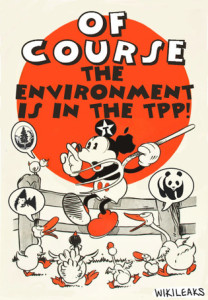Leaked: Secret Trans-Pacific Partnership Agreement (TPP) – Environment Chapter
TRADE, 20 Jan 2014
WikiLeaks – TRANSCEND Media Service
 Today, 15 January 2014, WikiLeaks released the secret draft text for the entire TPP (Trans-Pacific Partnership) Environment Chapter and the corresponding Chairs’ Report.
Today, 15 January 2014, WikiLeaks released the secret draft text for the entire TPP (Trans-Pacific Partnership) Environment Chapter and the corresponding Chairs’ Report.
The TPP transnational legal regime would cover 12 countries initially and encompass 40 per cent of global GDP and one-third of world trade. The Environment Chapter has long been sought by journalists and environmental groups. The released text dates from the Chief Negotiators’ summit in Salt Lake City, Utah, on 19-24 November 2013.
The Environment Chapter covers what the Parties propose to be their positions on: environmental issues, including climate change, biodiversity and fishing stocks; and trade and investment in ‘environmental’ goods and services. It also outlines how to resolve enviromental disputes arising out of the treaty’s subsequent implementation. The draft Consolidated Text was prepared by the Chairs of the Environment Working Group, at the request of TPP Ministers at the Brunei round of the negotiations.
When compared against other TPP chapters, the Environment Chapter is noteworthy for its absence of mandated clauses or meaningful enforcement measures. The dispute settlement mechanisms it creates are cooperative instead of binding; there are no required penalties and no proposed criminal sanctions. With the exception of fisheries, trade in ‘environmental’ goods and the disputed inclusion of other multilateral agreements, the Chapter appears to function as a public relations exercise.
Julian Assange, WikiLeaks’ publisher, stated: “Today’s WikiLeaks release shows that the public sweetner in the TPP is just media sugar water. The fabled TPP environmental chapter turns out to be a toothless public relations exercise with no enforcement mechanism.”
The Chairs’ Report of the Environment Working Group also shows that there are still significant areas of contention in the Working Group. The report claims that the draft Consolidated Text displays much compromise between the Parties already, but more is needed to reach a final text. The main areas of contention listed include the role of this agreement with respect to multilateral environmental agreements and the dispute resolution process.
The documents date from 24 November 2013 ─ the end of the Salt Lake City round. They were requested by the Ministers of the TPP after the August 2013 Brunei round. The Consolidated Text was designed to be a “landing zone” document to further the negotiations quickly and displays what the Chairs say is a good representation of all Parties’ positions at the time. The WikiLeaks Consolidated Text and corresponding Chairs’ Report show that there remains a lot of controversy and disagreement within the Working Group. The Consolidated Text published by WikiLeaks is not bracketed, as per the IP Chapter released in November 2013, as it is drafted by the Chairs of the Working Group at their responsibility. Instead, the accompanying Chairs’ Report provides commentary on the draft Consolidated Text and is the equivalent of bracketed disagreements for the countries that have not agreed on certain Articles, and provides their positions.
Current TPP negotiation member states are the United States, Japan, Mexico, Canada, Australia, Malaysia, Chile, Singapore, Peru, Vietnam, New Zealand and Brunei. This is the third in the series of Secret Trans-Pacific Partnership Agreement (TPP) leaks published by WikiLeaks.
Further reading:
TPP Environment Chapter Analysis by Professor Jane Kelsey, New Zealand
Secret Trans-Pacific Partnership Agreement (TPP) Series so far:
- TPP Intellectual Property Chapter
- TPP Agreement Documents
- TPP Environment Chapter Consolidated Text
- TPP Environment Chapter Working Group Chairs’ Report
Go to Original – wikileaks.org
DISCLAIMER: The statements, views and opinions expressed in pieces republished here are solely those of the authors and do not necessarily represent those of TMS. In accordance with title 17 U.S.C. section 107, this material is distributed without profit to those who have expressed a prior interest in receiving the included information for research and educational purposes. TMS has no affiliation whatsoever with the originator of this article nor is TMS endorsed or sponsored by the originator. “GO TO ORIGINAL” links are provided as a convenience to our readers and allow for verification of authenticity. However, as originating pages are often updated by their originating host sites, the versions posted may not match the versions our readers view when clicking the “GO TO ORIGINAL” links. This site contains copyrighted material the use of which has not always been specifically authorized by the copyright owner. We are making such material available in our efforts to advance understanding of environmental, political, human rights, economic, democracy, scientific, and social justice issues, etc. We believe this constitutes a ‘fair use’ of any such copyrighted material as provided for in section 107 of the US Copyright Law. In accordance with Title 17 U.S.C. Section 107, the material on this site is distributed without profit to those who have expressed a prior interest in receiving the included information for research and educational purposes. For more information go to: http://www.law.cornell.edu/uscode/17/107.shtml. If you wish to use copyrighted material from this site for purposes of your own that go beyond ‘fair use’, you must obtain permission from the copyright owner.